Mythlogic Pollux 1613 / Clevo P157SM Review
by Jarred Walton on August 30, 2013 12:00 AM ESTMythlogic Pollux 1613 Overclocking
One of Mythlogic’s claims to fame with their Clevo-based notebooks is that they’ve customized the BIOS to allow overclocking. I haven’t tested any other Clevo P157SM/P177SM notebooks so I don’t know if they’re done a lot or if they just tweaked a few items, but you’re able to raise the maximum CPU multiplier. I’m not sure if there’s a different limit imposed by Intel, but for the i7-4700MQ we could increase the single-core, dual-core, multi-core multiplier by two bins (3.6GHz max) whereas on the i7-4900MQ we’re allowed to go up to four bins above the maximum single-core clock, so 4.2GHz for all settings. It’s worth noting that we were not able to run at 4.2GHz stably, and in fact I couldn’t get the Clevo P157SM to even boot into Windows. I didn’t do any intense research, but ultimately I found that setting the CPU to 4.0GHz for all loads ran without crashing, so that’s what I tested.
Before we get to the charts, there’s on other tidbit I want to discuss that relates to Haswell. With Sandy Bridge and Ivy Bridge – and pretty much every CPU I can recall testing over the past decade or so – I’ve found that best performance is achieved using the High Performance power profile. However, at one point in the testing of the Clevo P157SM I ran some tests on the Balanced power profile. In most cases the difference wasn’t anything noteworthy, and often the High Performance profile was indeed faster, but in some games the choice of Balanced actually improves performance quite a bit – GRID 2 being the main beneficiary. Our best guess is that with some titles, selecting High Performance tries to run all the CPU cores at maximum clocks and may end up lowering the maximum Turbo Boost multiplier. With GRID 2, at our Value settings the Balanced profile ended up 15% faster, and even at our Mainstream settings there was still an 8% increase in frame rates (though this went away at the Enthusiast settings).
I mention this because all of the initial testing with overclocking and stock CPUs was done using the High Performance profile. I could go back and rerun every test on the Balanced profile to investigate the topic more, but that’s a lot of hours of running repetitive benchmarks for a relatively small payoff, and I’ve already benchmarked the P157SM far more than any other notebook in recent history. If the High Performance profile is indeed causing maximum Turbo Boost clocks to drop slightly because of increased heat, however, overclocking may further exacerbate the problem. If you end up buying one of these notebooks, I’d suggest at least looking at how the Balanced vs. High Performance profiles affect the games and applications you use. Of course, for laptops that I actually use, I tend to just stick with the Balanced profile as a good blend of battery life when I’m unplugged and performance when I’m plugged in, but it is an interesting change with Haswell regardless – possibly brought about by the integrated voltage regulator? Anyway, on with the overclocking benchmarks.
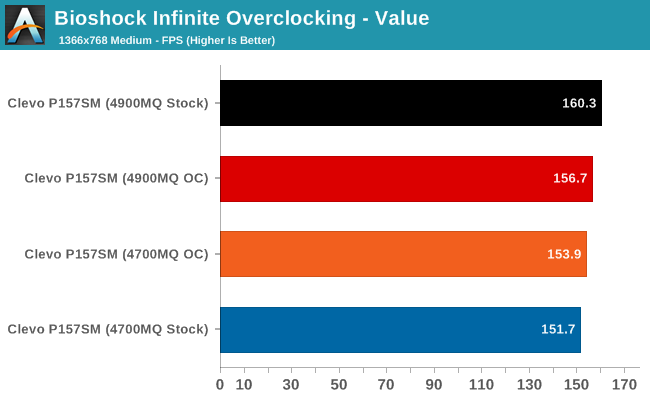
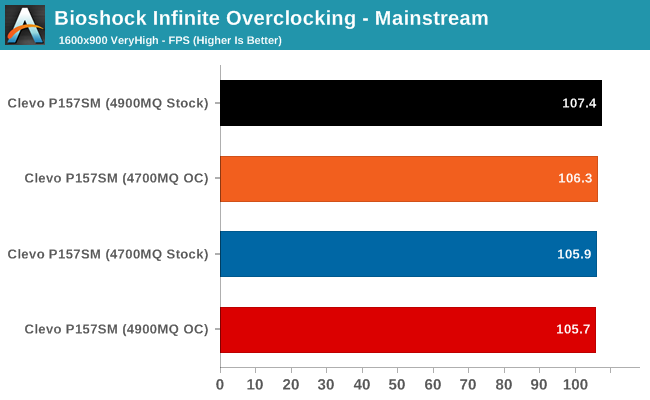
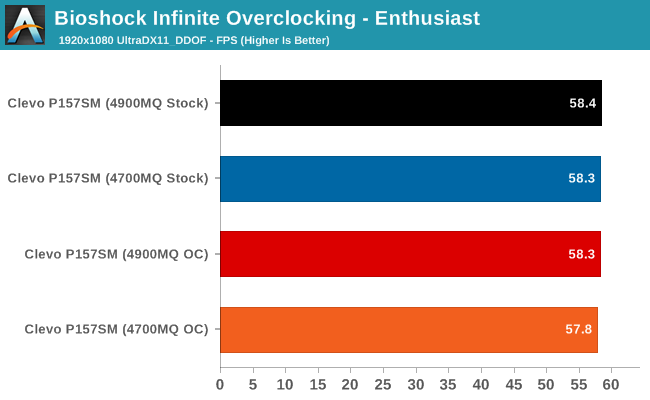
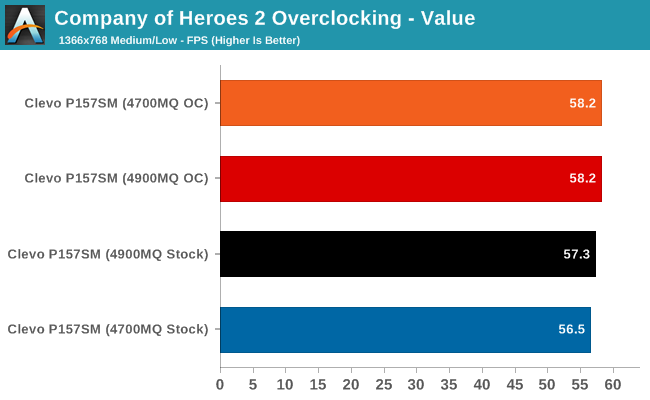
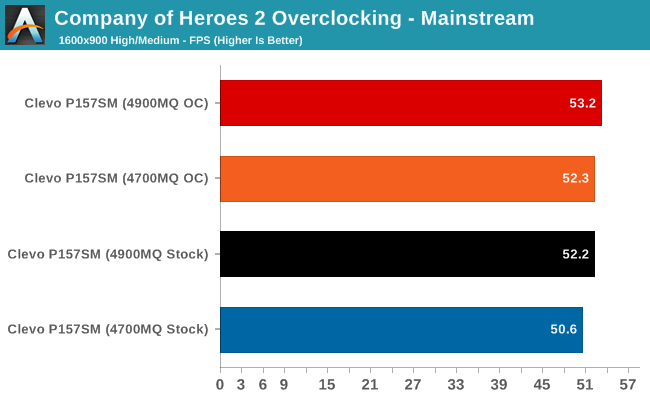
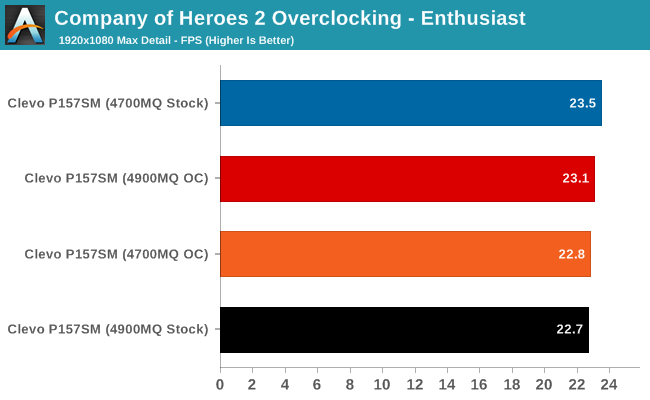
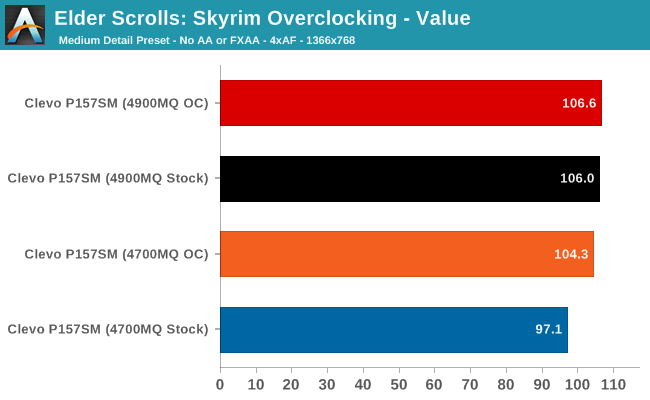
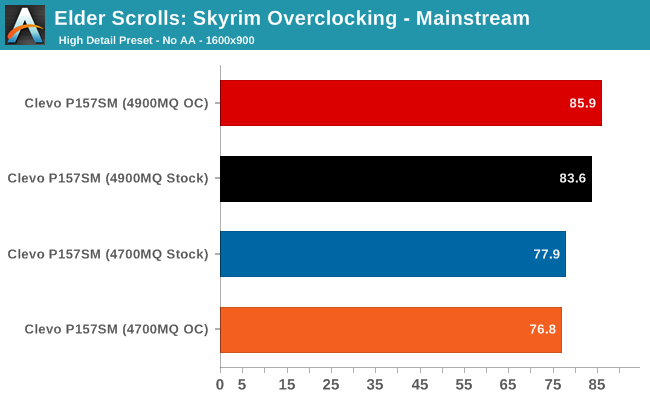
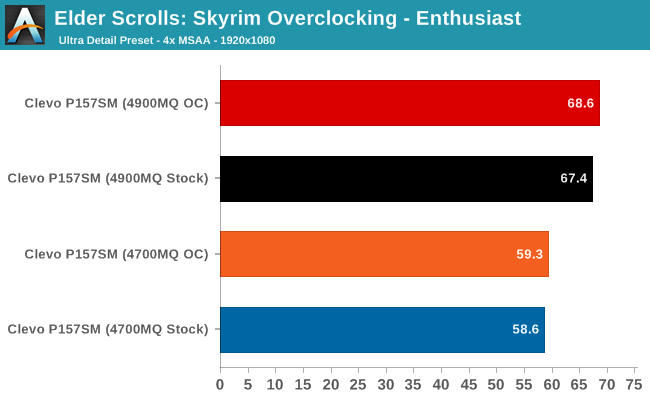
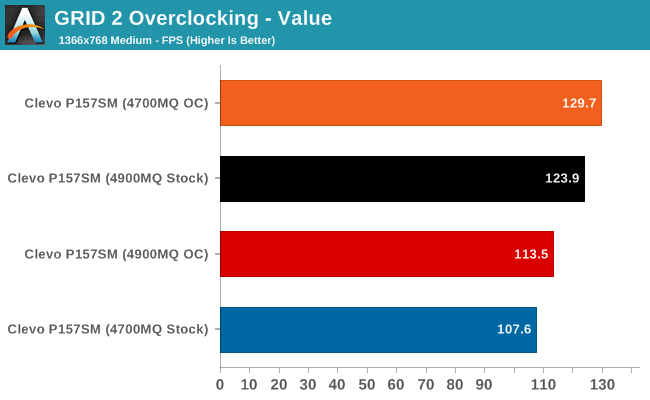
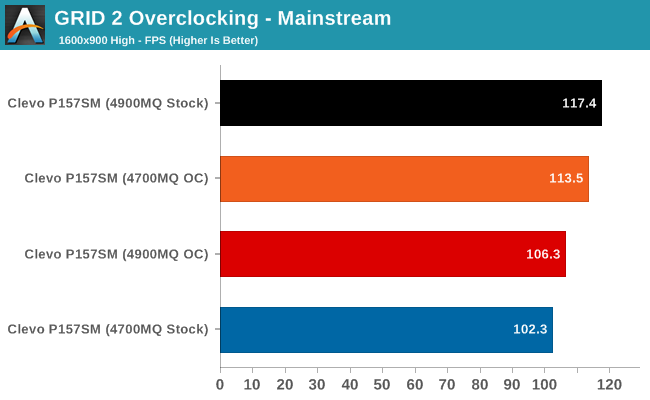

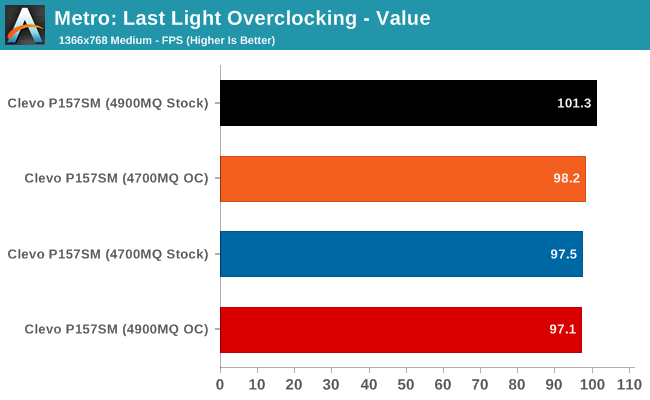
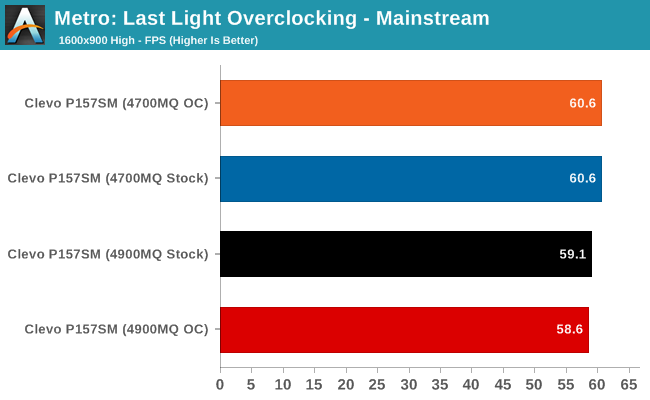
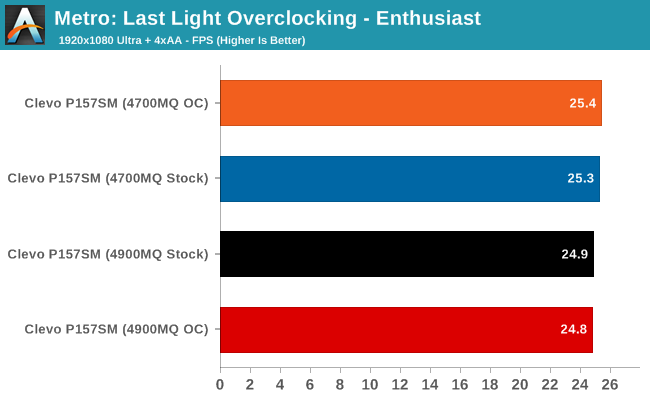
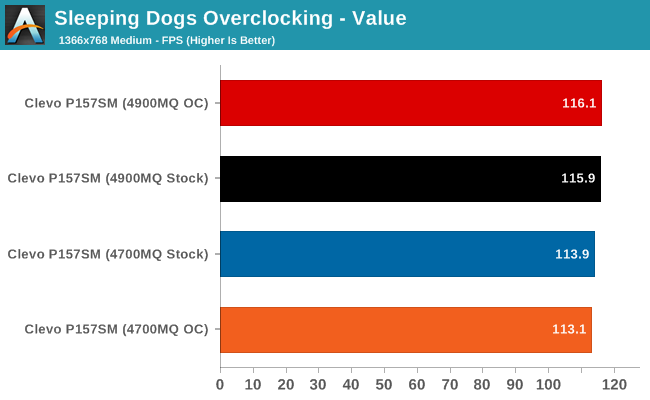
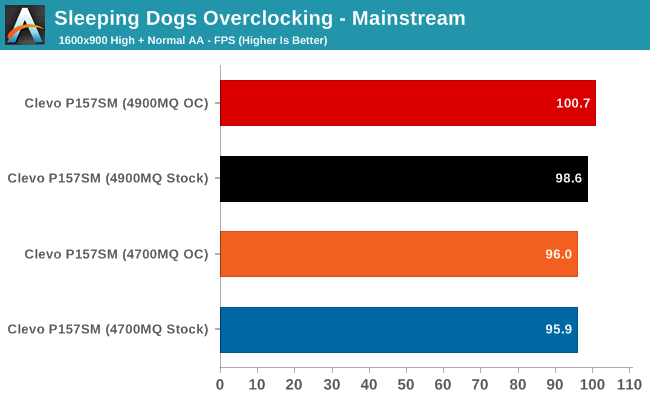
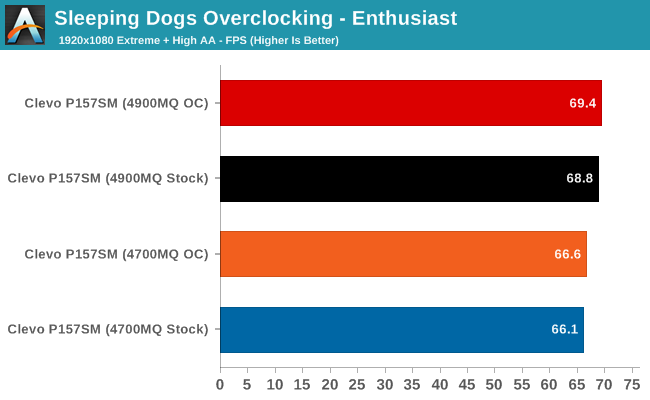

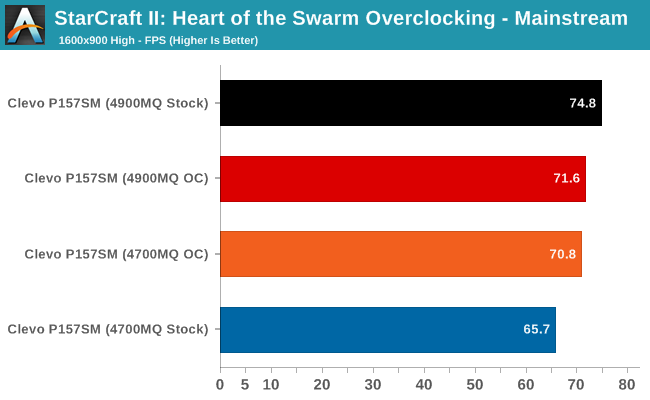
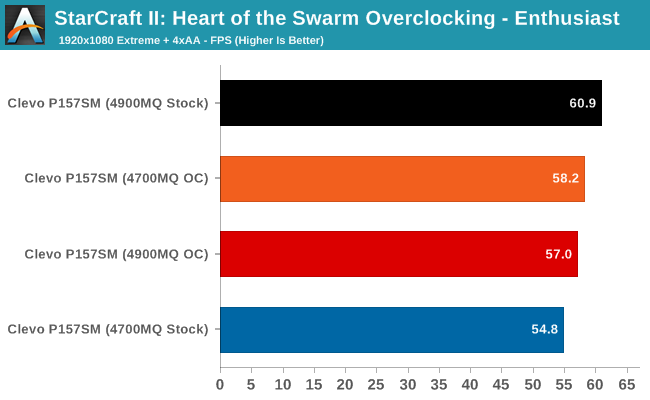
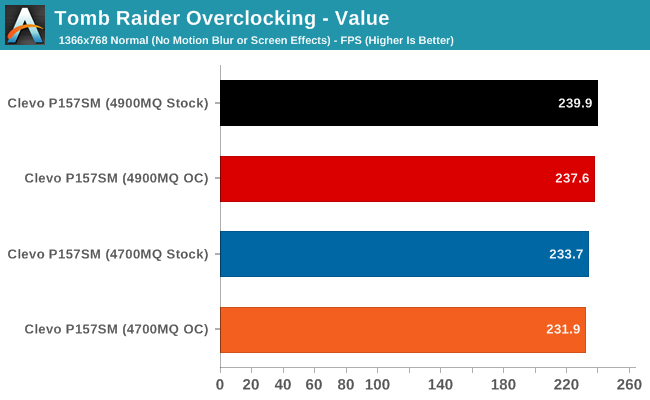
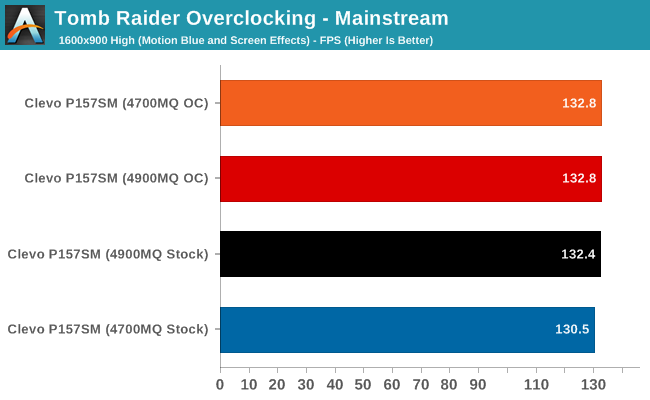

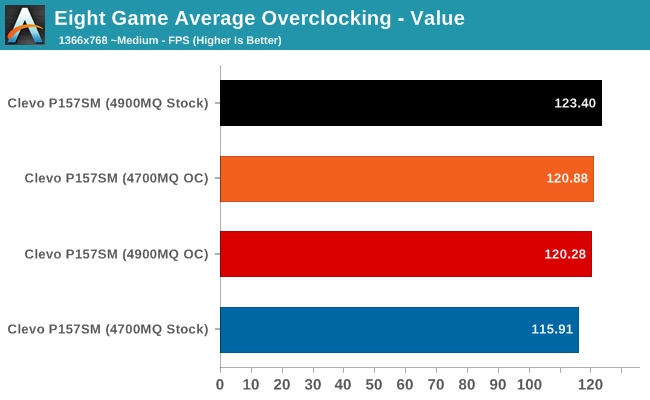
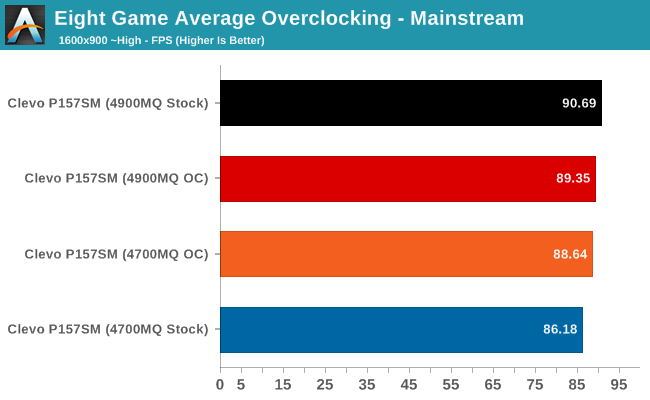
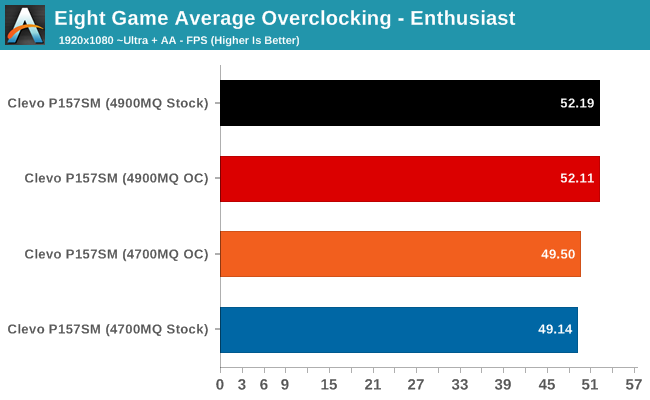
The same titles that benefit the most from the CPU upgrade should likewise benefit from overclocking. Skyrim, GRID 2, and StarCraft II apparently love having faster CPUs… but in practice, the gains from overclocking the CPU are small at best. The 4900MQ actually shows what I was talking about with the higher maximum clocks potentially ending up slower on average compared to the stock 4900MQ. In the end, the 4700MQ benefited more from overclocking than the 4900MQ, but perhaps with a bit more tuning I could coax the 4900MQ higher – like limiting the clocks to 4.0/3.9/3.8/3.7GHz for single/dual-triple/quad loads instead of setting them all to 4.0GHz. The short summary is that on average the stock 4900MQ is around 5-7% faster than the stock 4700MQ, while the overclocked 4900MQ is only 1-5% faster (and sometimes slower) than the overclocked 4700MQ.
Overall changes from overclocking the 4700MQ are anywhere from -3% to +8%, with larger changes at Value and Mainstream settings; the average change is +0.7% at Enthusiast, and +2% at Value and Mainstream. Overclocking of the 4900MQ shows changes ranging from -10% to +3%; GRID 2 and StarCraft II both drop in performance by more than 5%, so further tuning would be required to find a good balance. The 2-bin overclocking limit of the 4700MQ also prevents it from fully closing the gap with the stock 4900MQ, but it does get a bit closer.
There’s obviously a second question that I haven’t even touched on with regards to overclocking: can we get any additional performance out of the GTX 780M? Personally, with the GPU already hitting 85C under normal gaming use, I’m not inclined to push it harder. This is an expensive notebook with a very fast GPU, and until we get even higher resolution displays there’s really not much need to overclock the GPU. Others are welcome to do so, and I know some have already done so and posted results, but if I purchased a notebook like this I wouldn’t want to risk damaging a chip for a few more FPS.










47 Comments
View All Comments
JarredWalton - Sunday, September 1, 2013 - link
What he said for the GPU. As for mSATA, there are two mSATA positions in the P157SM, so you can use two mSATA and two 2.5" HDD/SSDs. No idea on the cooling and turbo stuff for MSI, but I'd guess they're all the same in terms of features; maybe someone else has a better answer.For the performance differences, it could be drivers, it could be firmware optimizations, and it could be differences in maximum sustained Turbo (due to differences in cooling). On the desktop we're at the point where if you use the same CPU and GPU, performance is basically identical within a few percent, but on laptops there's still a lot more variation. Hope that helps.
Freakie - Monday, September 2, 2013 - link
Hey Jarred, you wouldn't happen to be getting an ASUS N550 in anytime soon, would you?JarredWalton - Monday, September 2, 2013 - link
I'll request one, but at present no laptop from ASUS is in route.landsome - Tuesday, September 3, 2013 - link
I am still a bit puzzled by the inability of the single-fan solution of the MSI GT series to do well by Haswell+GTX780M. I have an old MSI GT663R and it keeps a 920XM @ 3.2GHz and a 7970M under control in prime+furmark, no throttling, CPU at 95C max, GPU at 87C. With a 820QM and the same vid card, it's around 85C+85C in the same scenario - and Clarksfield is a hot processor. I also owned an HP 8740W, and its single-fan solution was capable of cooling well a 920XM and a Quadro 5000M (also prime+furmark).So why this sudden weakness with the GT60 and GT70? (Also worth noting that the dual heatsinks on my GT663R are much heavier than the dual heatsinks on the Clevo P150EM I owned for a short while, while the fan is bigger and more potent than any of the two Clevo fans, though the Clevo did cool well too.)
JarredWalton - Tuesday, September 3, 2013 - link
Haswell is the same process as Ivy Bridge, so it's not really any cooler running -- it's just able to go into lower power states more quickly, more or less. In fact, it may run slightly hotter (not sure), all things considered. At present, the GT70 isn't throttling -- it's just running hotter than we'd like. Is it worth considering? For the right price, and if you like the styling more than the Clevos, sure. I don't think it's better, and you can get heavier copper heatsinks for Clevos from some vendors (XoticPC for instance), but go with what you think is best.paulfp - Saturday, December 14, 2013 - link
Battlefield 4 in Clevo http://j.gs/3B5Krickstones - Wednesday, April 16, 2014 - link
I have an order with Sager for a NP8258 (= Clevo P157SM). The original LCD panel was the 95% NTSC Gamut matt finish panel. I was just notified by Sager that this panel is no longer available due to "quality problems".Does anyone have information on what the problems are with this panel? Its been around for a pretty long time now, I don't know why they should begin experiencing quality problems at this point...
Also, I replaced this panel with the standard FHD matt finish panel. Anyone know if this this is a decent LCD? It was only $35 less than the 95% NTSC Gamut. I loaded this laptop up to the gills and am paying a lot of dough for it. I really don't want to be stuck with a subpar LCD.